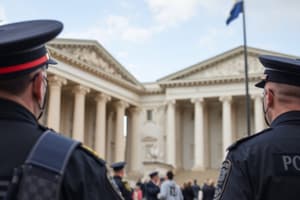Podcast
Questions and Answers
What is the main objective of the lesson plan on Contact, Detention, and Arrest?
What is the main objective of the lesson plan on Contact, Detention, and Arrest?
- To educate officers on the limits and consequences of police interactions with citizens (correct)
- To provide training on search and seizure procedures
- To discuss the role of Miranda in police interrogations
- To outline the Fourth Amendment and its provisions
What provision of the U.S. Constitution is relevant to the lesson plan?
What provision of the U.S. Constitution is relevant to the lesson plan?
- Fourth Amendment (correct)
- Eighth Amendment
- First Amendment
- Fifth Amendment
What is the primary distinction between a contact, a detention, and an arrest?
What is the primary distinction between a contact, a detention, and an arrest?
- Degree of suspicion required
- Level of force used
- Purpose of the interaction
- Type of interaction between officer and citizen (correct)
What type of Fourth Amendment seizure is a voluntary contact?
What type of Fourth Amendment seizure is a voluntary contact?
What is required to justify an investigative detention?
What is required to justify an investigative detention?
What must be documented when using handcuffs in a detention situation?
What must be documented when using handcuffs in a detention situation?
When can anonymous tips be used to develop reasonable suspicion?
When can anonymous tips be used to develop reasonable suspicion?
What is authorized in a detention situation if the suspect refuses to answer questions?
What is authorized in a detention situation if the suspect refuses to answer questions?
What is the primary source of law covering contact-detention and arrest?
What is the primary source of law covering contact-detention and arrest?
What is the minimum justification required for an arrest?
What is the minimum justification required for an arrest?
What is required for a detention to be considered reasonable?
What is required for a detention to be considered reasonable?
What is the legal authority required to arrest subjects in a third party's residence?
What is the legal authority required to arrest subjects in a third party's residence?
What is the purpose of the Fourth Amendment?
What is the purpose of the Fourth Amendment?
What is required to establish probable cause for arrest?
What is required to establish probable cause for arrest?
What type of search may be authorized by an arrest?
What type of search may be authorized by an arrest?
What is the purpose of RSMo Sec. 544.216?
What is the purpose of RSMo Sec. 544.216?
Flashcards are hidden until you start studying
Study Notes
Contact, Detention, and Arrest
- Examines three levels of interaction an officer/deputy can have with a citizen while acting under color of law: contact, detention, and arrest.
- Each type has specific recognized limits, requirements, and consequences for police officers.
Introduction to Fourth Amendment
- The First major provision of the Fourth Amendment to the U.S. Constitution deals with the procedure for seizing of persons.
- It is the source of law covering contact, detention, and arrest.
Voluntary Contacts
- A voluntary contact is a type of Fourth Amendment seizure.
- Minimum justification - how much information - is needed: minimal.
- Force used to maintain a voluntary contact: minimal.
- Search authorized by a voluntary contact: consent search.
- Miranda is required during a voluntary contact if one wishes to ask guilt-seeking questions.
Investigative or Temporary Detentions
- An investigative detention is a type of Fourth Amendment seizure.
- Minimum justification - how much information - is needed: reasonable suspicion.
- Facts and sources of facts that may be used to develop reasonable suspicion: specific and articulable facts, anonymous tips (conditional).
- Three general restrictions on detentions:
- Limited duration.
- Limited scope.
- No probable cause for arrest.
- Documentation requirements for using handcuffs in a detention situation: to prevent it from becoming a de facto arrest.
- Search authorized for a detained suspect: limited search incident to detention.
- Miranda is required during a detention if one wishes to ask guilt-seeking questions.
- If the suspect refuses to answer questions, the officer may still detain and ask further questions.
Arrests
- An arrest is a type of Fourth Amendment seizure.
- Minimum justification - how much information - is needed: probable cause.
- Types of facts and sources of facts that may be used to develop probable cause: specific and articulable facts, sworn testimony.
- Limitations on the officer's surveillance of a suspect after arrest: none.
- Force used to maintain an arrest: reasonable force.
- Requirements for use of deadly force to make an arrest: only when necessary.
- Search authorized by an arrest: full search incident to arrest.
- Miranda is required during an arrest if one wishes to ask guilt-seeking questions.
Reasonable Suspicion and Probable Cause
- Two issues that must be reasonably suspected to establish reasonable suspicion for a detention:
- Particularized suspicions.
- Objective observations.
- Two issues that must be reasonably believed to establish probable cause for arrest:
- Factual basis.
- Connection to criminal activity.
- Four factors that may be used to establish the reliability of information from a criminal informant:
- Veracity.
- Reliability.
- Basis of knowledge.
- Corroboration.
Legal Authority for Arrests
- Legal authority required to arrest subjects:
- In a public place: none.
- In the suspect's residence: warrant or exigent circumstances.
- In a third party's residence: warrant or consent.
- Authority granted to peace officers by RSMo Sec. 544.216 regarding arrests for traffic violations and ordinances:
- Authority to arrest.
- Issues, if any, of pretext raised by this authority.
Studying That Suits You
Use AI to generate personalized quizzes and flashcards to suit your learning preferences.




